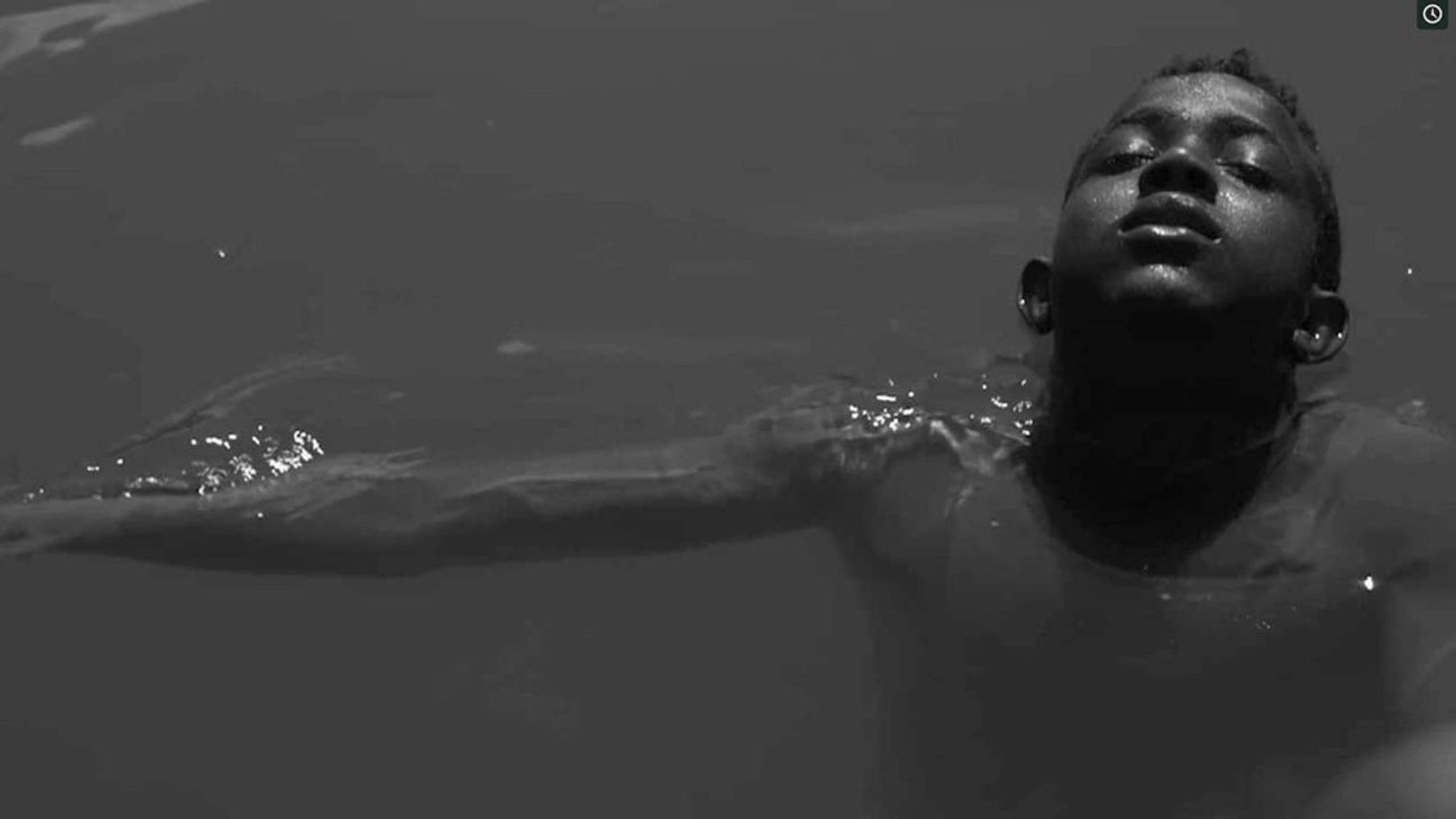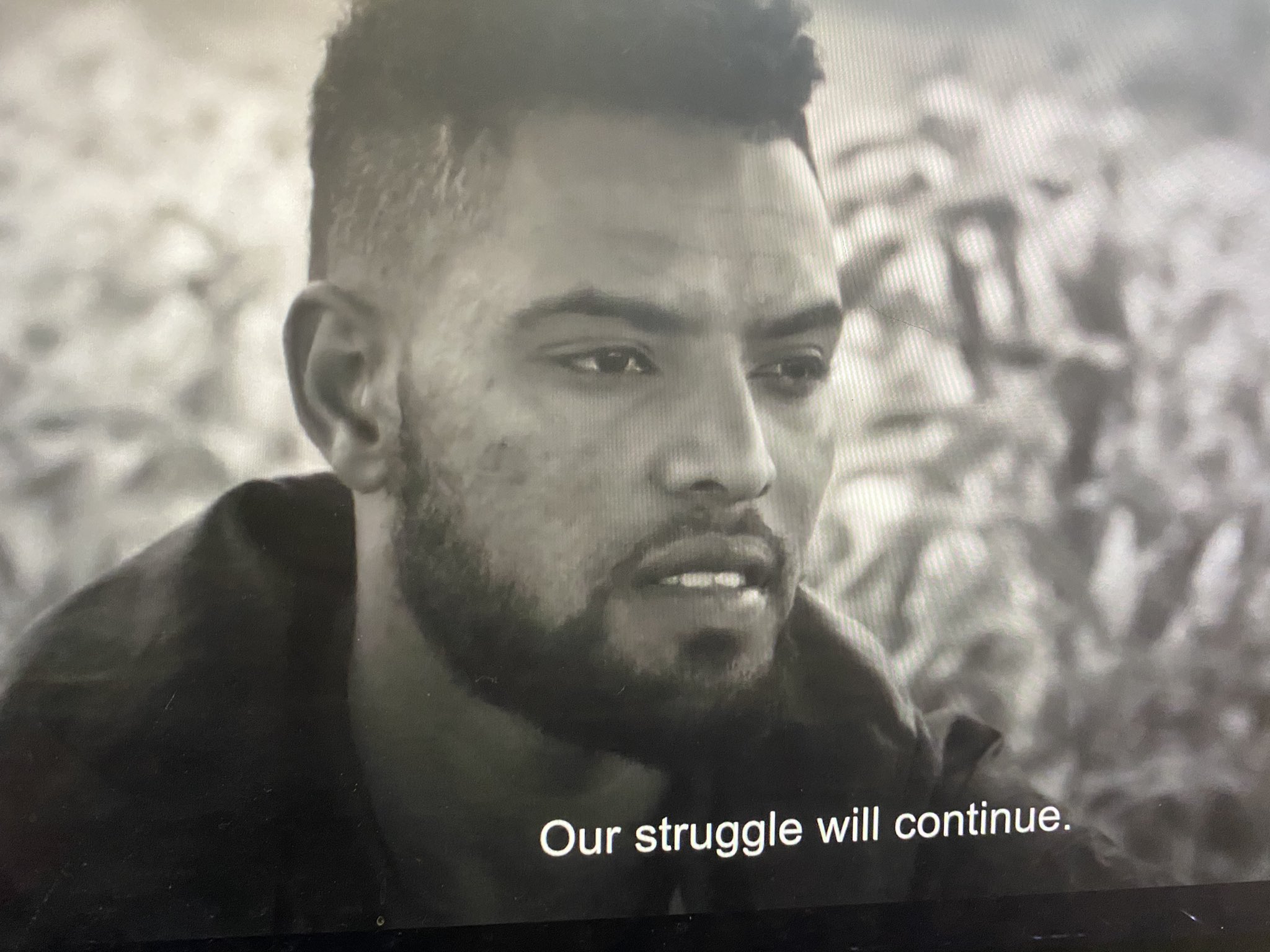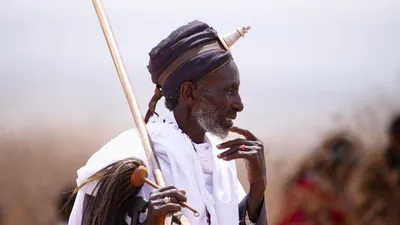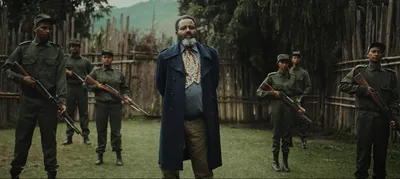A Journey to Harar

Still from Faya Dayi.
A Harari folktale relates the story of Azurkherlaini, an elderly emir who speaks to God in a dream as his death looms near. To quell his fears, God commands him to seek out Maoul Hayat—the water of eternal life—and he embarks on the journey with two other emirs, Khedir and Elias. Khedir, who finds the water first, is transformed into daylight after a drink, while Elias, the next to arrive, turns into the darkness of night when he sips on the muddy remnants. Azurkherlaini arrives too late, the water having dried up. God instead grows khat in its place, telling him that “whoever eats khat will always remember you.”
More than simply offering a narrative structure, the story of Azurkherlaini weaves together many of the themes in Mexican-Ethiopian director Jessica Beshir’s stunning debut documentary feature film, Faya Dayi (2021). It interlaces the landscapes and ecology of eastern Ethiopia and the Harar plateau in particular, the dreams and disappointments of its inhabitants, the role of history and collective memory, the centrality of Islamic religiosity, and, of course, khat. Like coffee, the leafy stimulant plant is native to the Horn of Africa and has a long history of use in social rituals as well as in Sufi Muslim spiritual practice.

A scene in Faya Dayi echoes Azurkherlaini, bringing the histories of the two stimulants together as a group of Oromo farmers cultivating khat drink coffee under the shade of a tree. “Our coffee was beautiful,” a man tells the others, reminiscing over how he and his father once grew coffee, “but it needed a lot of rain. We replaced it with khat.” As they return to laboring in the khat fields, we hear the title of the documentary as an expression within an Afaan Oromo work song, its rhythms synchronizing their movements: faya dayi, give birth to health.
Khat, which requires less water and attention than coffee, is Ethiopia’s most lucrative cash crop. The walled, ancient city of Harar and its adjacent areas of Oromia, the focus of Beshir’s directorial gaze, constitute the largest khat-producing and exporting area in the world. Beshir, however, chooses to introduce the viewer to khat as more than an increasingly important export product in a capitalist economy; she finds ways to capture khat’s roles and meanings in everyday Harari life. Our first glimpse of khat come with the slow-moving, black and white imagery that characterizes the film: an incense smoke-filled room, partial views of men in traditional sarongs, tasbih prayer beads, kufi skull caps, and the sounds of Quran recitation, prayer, the buzzing of house flies, the pounding of a mortar and pestle. This is Harar, the city of Sufi saints and Islamic learning, the thoroughfare bridging the Ethiopian highlands and the Somali coast.
Faya Dayi is not your usual documentary. There are no talking heads informing us about the political economy of khat, no interviews with its cultivators, exporters, sellers, or consumers. Instead, what Beshir offers is an immersive experience that uses hazy, dreamlike sounds and images to evoke and mirror the experience of chewing khat and its addictive high known in the region as merkhana (or mirqaan). Individual stories are told in non-linear fragments: teenage boys discussing how to migrate to Europe, a group of women preparing for a wedding, an elderly man singing of heartbreak, a lonely wife lamenting over the loss of her husband to merkhana. These narratives come in and out of focus, winding through Faya Dayi and almost mimicking the labyrinthine geography of historic Harar Jugol and its narrow, maze-like alleys. The many fragments combine to piece together a deeply human, affective picture of the inner lives of Harar’s residents, bound as they are to khat’s pleasures and discontents. Harar, the center of khat’s production and distribution in the Horn of Africa—and, indeed, khat itself—are the film’s most consistent and enduring characters.
Time in Faya Dayi is elusive, but the lifecycle of khat offers some semblance of temporal structure. Khat leaves begin to wither and lose potency within 48 hours of harvesting; trucks deliver fresh khat to other Ethiopian cities and across the border to export markets in Somaliland and Djibouti. The film slows down the breakneck, controlled chaos of the khat industry, with close scenes of farmers harvesting the plant; of warehouse laborers sifting through and bundling the leaves; of truck drivers loading up thousands of kilos of product and distributing the bundles to khat sellers in the market. We see glimpses of its consequences, too. One scene shows a teenage boy starting a job in one of the khat warehouses, replacing his late father as the family’s breadwinner; a fellow worker urges him to continue attending school during the day. The immediate scenes that follow include a khat truck that has run off the road in a serious accident, silently gesturing toward what may have happened to him not long after.
Apart from the folktale of Azurkherlaini, which is interspersed throughout the documentary and completed towards the end of the film, the personal narrative that receives the fullest treatment is that of Mohammed, a teenage boy we see in the khat fields early on but more often delivering khat and tobacco to neighbors in the city. We learn that his mother has left the family and migrated elsewhere, presumably across the Mediterranean or Red Sea, and that his father is abusive and addicted to khat. Mohammed’s father—a younger man whose solitary chews involve listening to pop music on his phone when he is not barking insults at his son or cursing his absent wife—represents a modern iteration of khat use, in contrast to the older men of faith we see chewing as a part of communal religious practice. The merkhana that was once a mode of achieving spiritual ecstasy and closeness to God, ritualized in its use like incense and menzuma chants and praise songs, has been divorced from traditional Sufi Muslim worship in our present.
What emerges in tandem with khat’s rise as a cash crop in Ethiopia is complete dependency: biopsychosocial and economic. In a context of high unemployment, the khat industry offers one of the very few avenues for meaningful work in eastern Ethiopia, yet it is also unemployment—and disillusion with life in Ethiopia more generally—which fuels what is fast becoming an addiction crisis. For Mohammed and many other youths, the only future they see for themselves is abroad, and they are therefore willing to wager their lives to make the dangerous journey to and across the Mediterranean. This palpable sense of hopelessness and despair runs against a feeling of cautious optimism that is rooted in the Islamic belief in the power of the divine to change one’s circumstances, a lesson embedded in the story of Azurkherlaini. One man is shown praying for God to “make our dreams come true,” while another cries, “the Creator fulfils . . . the times are cruel, may He help us.”

The times he refers to, as we see later, are those of the ongoing, violent state suppression of Oromo political expression, which only intensified after a brief moment of democratic opening brought on by the 2014–2016 Oromo protests. In one scene, a woman describes the mass detentions and their impact on her family as her friend comforts her with the words that “everything is in God’s hands.” In another scene, a young man involved in the movement says that as Oromos, “our struggle is not new, our grandparents and great grandparents went through it.” This moment recalls a khat farmer’s earlier remark that “every regime has kept us from working our own fertile land,” reminding viewers that much of Ethiopia’s political challenges are rooted in its histories of land, labor, and ethnic domination.
Faya Dayi is an impressive film, a kaleidoscopic look at everyday life in eastern Ethiopia through the lens of khat and Oromo Muslim subjectivity. Its genre-defying, experimental qualities raise the question of the extent to which scripted and fictional elements were used; similarly, the lack of interviews and overarching narrative voice can make it somewhat difficult to follow or learn more about its subject matter. These concerns cease, however, when one approaches the film as an experience like merkhana—allowing Jessica Beshir to immerse you in the Sufi Muslim world of Harar.
Source: Africa is a Country.
We need your support
We trust you found something of value in this article. If so, we kindly ask you to consider helping Curate Oromia continue its work.
If you believe in the importance of independent voices and honest reporting, we invite you to support our efforts through our GoFundMe campaign.
Every contribution, however small, goes directly to our writers and the expansion of our reach.
Thank you for your support.



